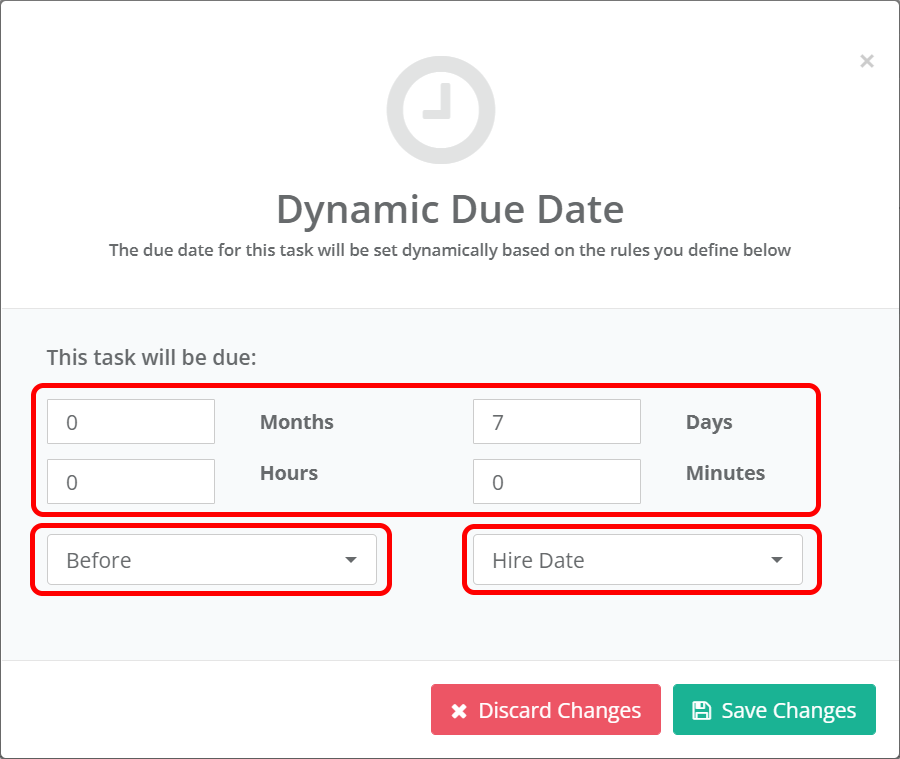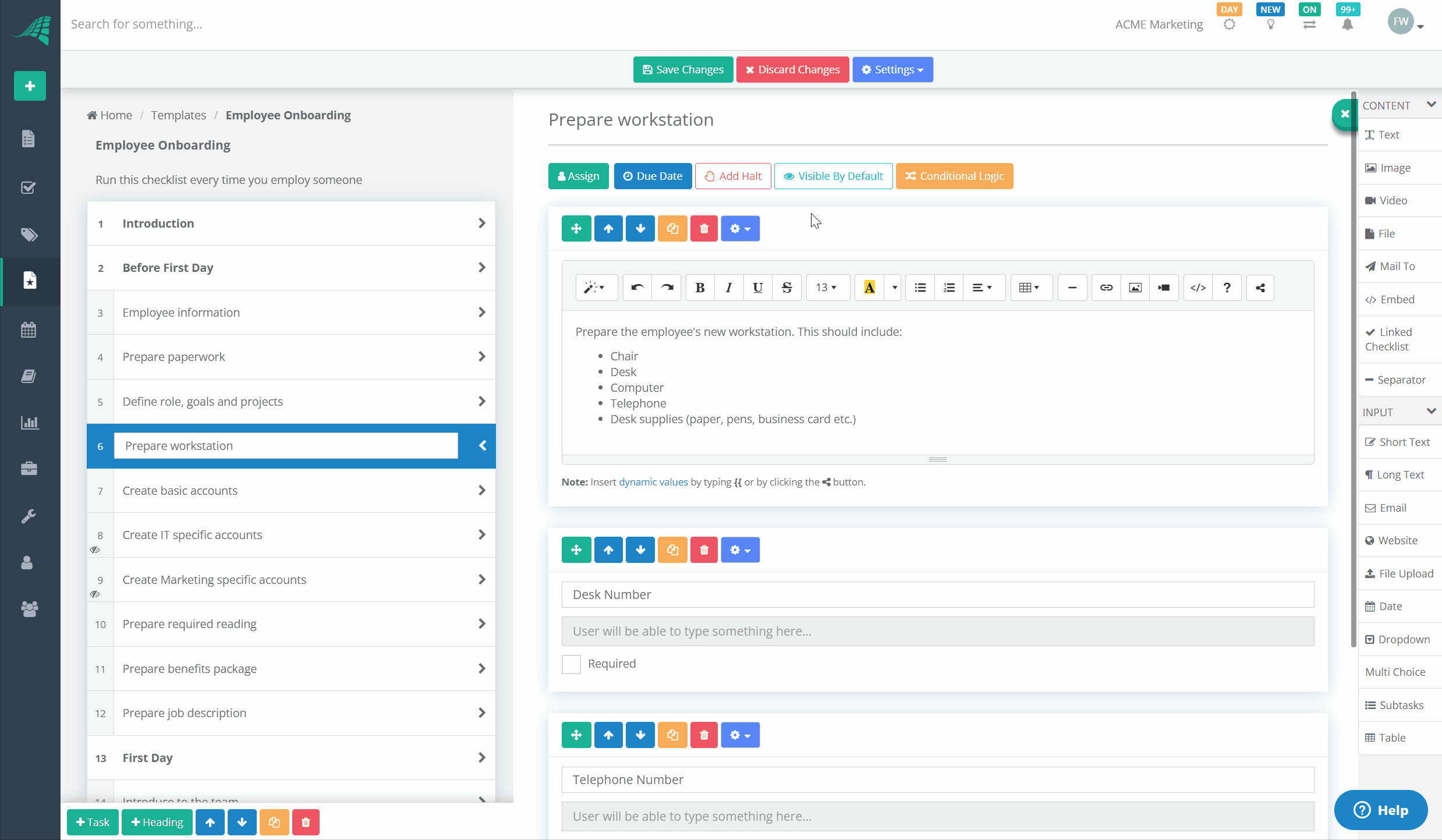Dynamic Due Dates
Dynamic due dates allow you to affect a task’s due date based on rules you define within your template. Each of your checklists inherit these rules and apply them dynamically at run time.
You can anchor your due dates to the start of your checklist, the completion of other tasks, and to any date controls within your checklist.
This enables you to connect deadlines and tasks to one another in powerful ways.
Example Use Cases
- Your process timings are tied to the start date. All of your tasks have a due date based on the number of minutes, hours, days or months after your process has started.
- Your new employee starts in 4 weeks. You have a set of tasks that must be completed prior to their start so that they have everything they need on their first day (before the "Hire Date" control value).
- Your new employee also has to complete their orientation and training by the end of their first two weeks (after the "Hire Date" control value).
- Your accounting team have sent an invoice to one of your customers. They must also check if the invoice has been paid 7 days after the invoice has been sent (after the "Send Invoice" task has been completed).
Dynamic Due Date Anchors & Triggers
Dynamic due dates are anchored to either:
- The checklist start date
- The completion of the previous task
- The completion of a specific task
- Any date control within your checklist
You can specify that the dynamic due date should trigger after:
- The checklist has started
- The completion of a task
- The value entered in to a date control within your checklist
The dynamic due date can also trigger before:
- The value entered in to a date control within your checklist
The rules will automatically adjust the due date of tasks as various actions are taken within your checklist.
Creating a Dynamic Due Date
Dynamic due dates are created within your process template.
Open your template and select the task you want to create a dynamic due date for in the tasks list.
A toolbar is displayed at the top of the task content area. From this toolbar click the Due Date button.

A popup form will be displayed. The form is comprised of three sections:
- The upper section allows you to define how many months, days, hours and minutes you want to calculate your due date from.
- The bottom left section allows you to select whether the rule will be triggered before or after your chosen anchor.
- The bottom right section allows you to select what the rule will be anchored to.

Define your due date rule using these controls and then click the Save Changes button to close the popup and continue.
Example
In the example below we have added a dynamic due date to the Prepare Workstation task within our Employee Onboarding process template. We specified that this task should be due 7 days before the value entered in to the Hire Date control.

Modifying or Deleting a Dynamic Due Date
You can modify or delete an existing Due Date rule in the same way.
Open your template and select the task you want to edit the due date for. Click the Due Date button.
The popup form will be displayed. Make the required changes to your existing due date rule and then click the Save Changes button.
Dynamic Due Dates Within Your Checklists
Dynamic due dates rules are defined in your template. These rules are then applied to all checklists that are dervied from your template.
The due dates are altered dynamically in response to various actions taken within your checklist.
- Dynamic due dates anchored to the checklist start date are calculated when the checklist is created.
- Dynamic due dates anchored to the completion of a task will be calculated when the task is completed.
- Dynamic due dates anchored to a date control will be calculated when the date control value changes.
Override Due Dates
You can override dynamic due dates within your checklist.
Open your checklist, select the task and click on the 'Due' button. The current date and time the due date is set to will be diplayed in this button.
Use the date picker to change the due date to a new date and time. Then click the 'Save Due Date' button.
To remove the due date entirely, click the 'Clear Due Date' button and then click the 'Save Due Date' button.
Due Date Warnings
Due dates are displayed in the tasks list. The due date is displayed in small red text underneath the task name.
A color coded warning icon is also displayed. You can hover over this icon to display the full details.
The three states are as follows:
- Due In Future (Turquoise) - When the due date is greater than 1 hour in the future.

- Due Within Hour (Orange) - When the due date is within the next hour.

- Overdue (Red) - When the due date has passed.

Task Overdue Emails & Inbox Notifications
When a task becomes overdue an email and inbox notification is sent to all task assignees. If there are no task assignees we send these to all team members in the Administrator role.
The email contains the details of the overdue task and a clickable link which will take the user straight to the overdue task.

Unsubscribe From Overdue Emails
Users can unsubscribe from receiving overdue emails in their user settings.
Inbox Notification
The inbox notification can be accessed by clicking on the bell icon located at the top right.
The details of the overdue task are displayed in the notification message and a clickable link is included which will take the user straight to the overdue task.
